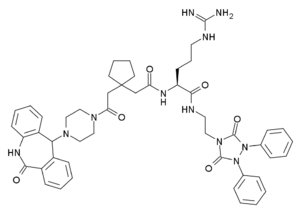Chemistry:BIIE-0246
 | |
| Clinical data | |
|---|---|
| Other names | BIIE-0246 |
| Identifiers | |
| |
| CAS Number | |
| PubChem CID | |
| IUPHAR/BPS | |
| ChemSpider | |
| UNII | |
| Chemical and physical data | |
| Formula | C49H57N11O6 |
| Molar mass | 896.066 g·mol−1 |
| 3D model (JSmol) | |
| |
| |
| | |
BIIE-0246 is a drug used in scientific research which acts as a potent and selective antagonist for the Neuropeptide Y receptor Y2.[1] It was one of the first non-peptide Y2-selective antagonists developed, and remains among the most widely used tools for studying this receptor. It has been used to demonstrate a role for the Y2 subtype as a presynaptic autoreceptor limiting further neuropeptide Y release,[2][3] as well as modulating dopamine[4] and acetylcholine release.[5] It has also been shown to produce several behavioural effects in animals, including reducing alcohol consumption in addicted rats[6][7] and anxiolytic effects,[8] although while selective Y2 agonists are expected to be useful as anorectics,[9][10] BIIE-0246 did not appear to increase appetite when administered alone.[11]
References
- ↑ "BIIE0246: a selective and high affinity neuropeptide Y Y(2) receptor antagonist". European Journal of Pharmacology 384 (2–3): R3–5. November 1999. doi:10.1016/S0014-2999(99)00650-0. PMID 10611450.
- ↑ "Effect of a selective neuropeptide Y Y(2) receptor antagonist, BIIE0246 on neuropeptide Y release". European Journal of Pharmacology 396 (1): R1–3. May 2000. doi:10.1016/S0014-2999(00)00230-2. PMID 10822055.
- ↑ "Autoinhibitory function of the sympathetic prejunctional neuropeptide Y Y(2) receptor evidenced by BIIE0246". European Journal of Pharmacology 439 (1–3): 113–9. March 2002. doi:10.1016/S0014-2999(02)01371-7. PMID 11937100.
- ↑ "Neuropeptide Y-induced enhancement of the evoked release of newly synthesized dopamine in rat striatum: mediation by Y2 receptors". Neuropharmacology 52 (6): 1396–402. May 2007. doi:10.1016/j.neuropharm.2007.01.018. PMID 17382974.
- ↑ "Neuropeptide Y reduces acetylcholine release and vagal bradycardia via a Y2 receptor-mediated, protein kinase C-dependent pathway". Journal of Molecular and Cellular Cardiology 44 (3): 477–85. March 2008. doi:10.1016/j.yjmcc.2007.10.001. PMID 17996892.
- ↑ "Blockade of central neuropeptide Y (NPY) Y2 receptors reduces ethanol self-administration in rats". Neuroscience Letters 332 (1): 1–4. October 2002. doi:10.1016/S0304-3940(02)00904-7. PMID 12377370.
- ↑ "Suppression of ethanol self-administration by the neuropeptide Y (NPY) Y2 receptor antagonist BIIE0246: evidence for sensitization in rats with a history of dependence". Neuroscience Letters 375 (2): 129–33. February 2005. doi:10.1016/j.neulet.2004.10.084. PMID 15670655.
- ↑ "Anxiolytic-like effect of the selective neuropeptide Y Y2 receptor antagonist BIIE0246 in the elevated plus-maze". Peptides 27 (12): 3202–7. December 2006. doi:10.1016/j.peptides.2006.07.020. PMID 16959374.
- ↑ "Neuropeptide Y2 receptors as drug targets for the central regulation of body weight". Current Opinion in Investigational Drugs 6 (10): 1002–11. October 2005. PMID 16259221.
- ↑ "Neuropeptide Y Y2 receptor in health and disease". British Journal of Pharmacology 153 (3): 420–31. February 2008. doi:10.1038/sj.bjp.0707445. PMID 17828288.
- ↑ "Intravenous peptide YY3-36 and Y2 receptor antagonism in the rat: effects on feeding behaviour". Journal of Neuroendocrinology 17 (7): 452–7. July 2005. doi:10.1111/j.1365-2826.2005.01330.x. PMID 15946163.
 |

